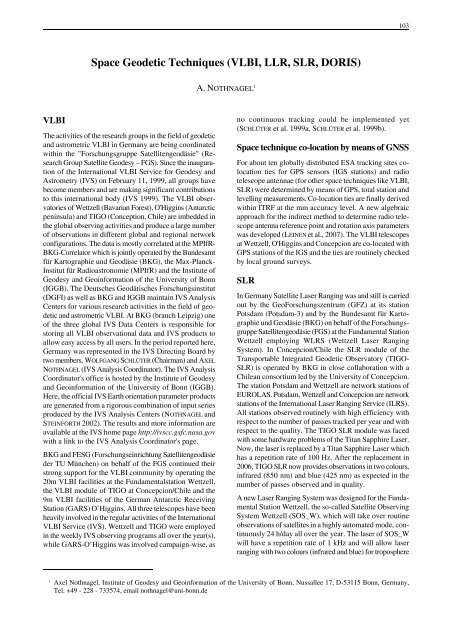NATIONAL REPORT OF THE FEDERAL REPUBLIC OF ... - IAG Office
NATIONAL REPORT OF THE FEDERAL REPUBLIC OF ... - IAG Office
NATIONAL REPORT OF THE FEDERAL REPUBLIC OF ... - IAG Office
Create successful ePaper yourself
Turn your PDF publications into a flip-book with our unique Google optimized e-Paper software.
VLBI<br />
Space Geodetic Techniques (VLBI, LLR, SLR, DORIS)<br />
The activities of the research groups in the field of geodetic<br />
and astrometric VLBI in Germany are being coordinated<br />
within the "Forschungsgruppe Satellitengeodäsie" (Research<br />
Group Satellite Geodesy – FGS). Since the inauguration<br />
of the International VLBI Service for Geodesy and<br />
Astrometry (IVS) on February 11, 1999, all groups have<br />
become members and are making significant contributions<br />
to this international body (IVS 1999). The VLBI observatories<br />
of Wettzell (Bavarian Forest), O'Higgins (Antarctic<br />
peninsula) and TIGO (Conception, Chile) are imbedded in<br />
the global observing activities and produce a large number<br />
of observations in different global and regional network<br />
configurations. The data is mostly correlated at the MPIfR-<br />
BKG-Correlator which is jointly operated by the Bundesamt<br />
für Kartographie und Geodäsie (BKG), the Max-Planck-<br />
Institut für Radioastronomie (MPIfR) and the Institute of<br />
Geodesy and Geoinformation of the University of Bonn<br />
(IGGB). The Deutsches Geodätisches Forschungsinstitut<br />
(DGFI) as well as BKG and IGGB maintain IVS Analysis<br />
Centers for various research activities in the field of geodetic<br />
and astrometric VLBI. At BKG (branch Leipzig) one<br />
of the three global IVS Data Centers is responsible for<br />
storing all VLBI observational data and IVS products to<br />
allow easy access by all users. In the period reported here,<br />
Germany was represented in the IVS Directing Board by<br />
two members, WOLFGANG SCHLÜTER (Chairman) and AXEL<br />
NOTHNAGEL (IVS Analysis Coordinator). The IVS Analysis<br />
Coordinator's office is hosted by the Institute of Geodesy<br />
and Geoinformation of the University of Bonn (IGGB).<br />
Here, the official IVS Earth orientation parameter products<br />
are generated from a rigorous combination of input series<br />
produced by the IVS Analysis Centers (NOTHNAGEL and<br />
STEINFORTH 2002). The results and more information are<br />
available at the IVS home page http://ivscc.gsfc.nasa.gov<br />
with a link to the IVS Analysis Coordinator's page.<br />
BKG and FESG (Forschungseinrichtung Satellitengeodäsie<br />
der TU München) on behalf of the FGS continued their<br />
strong support for the VLBI community by operating the<br />
20m VLBI facilities at the Fundamentalstation Wettzell,<br />
the VLBI module of TIGO at Concepcion/Chile and the<br />
9m VLBI facilities of the German Antarctic Receiving<br />
Station (GARS) O’Higgins. All three telescopes have been<br />
heavily involved in the regular activities of the International<br />
VLBI Service (IVS). Wettzell and TIGO were employed<br />
in the weekly IVS observing programs all over the year(s),<br />
while GARS-O’Higgins was involved campaign-wise, as<br />
A. NOTHNAGEL 1<br />
1 Axel Nothnagel, Institute of Geodesy and Geoinformation of the University of Bonn, Nussallee 17, D-53115 Bonn, Germany,<br />
Tel. +49 - 228 - 733574, email nothnagel@uni-bonn.de<br />
103<br />
no continuous tracking could be implemented yet<br />
(SCHLÜTER et al. 1999a, SCHLÜTER et al. 1999b).<br />
Space technique co-location by means of GNSS<br />
For about ten globally distributed ESA tracking sites colocation<br />
ties for GPS sensors (IGS stations) and radio<br />
telescope antennae (for other space techniques like VLBI,<br />
SLR) were determined by means of GPS, total station and<br />
levelling measurements. Co-location ties are finally derived<br />
within ITRF at the mm accuracy level. A new algebraic<br />
approach for the indirect method to determine radio telescope<br />
antenna reference point and rotation axis parameters<br />
was developed (LEINEN et al., 2007). The VLBI telescopes<br />
at Wettzell, O'Higgins and Concepcion are co-located with<br />
GPS stations of the IGS and the ties are routinely checked<br />
by local ground surveys.<br />
SLR<br />
In Germany Satellite Laser Ranging was and still is carried<br />
out by the GeoForschungszentrum (GFZ) at its station<br />
Potsdam (Potsdam-3) and by the Bundesamt für Kartographie<br />
und Geodäsie (BKG) on behalf of the Forschungsgruppe<br />
Satellitengeodäsie (FGS) at the Fundamental Station<br />
Wettzell employing WLRS (Wettzell Laser Ranging<br />
System). In Concepcion/Chile the SLR module of the<br />
Transportable Integrated Geodetic Observatory (TIGO-<br />
SLR) is operated by BKG in close collaboration with a<br />
Chilean consortium led by the University of Concepcion.<br />
The station Potsdam and Wettzell are network stations of<br />
EUROLAS. Potsdam, Wettzell and Concepcion are network<br />
stations of the International Laser Ranging Service (ILRS).<br />
All stations observed routinely with high efficiency with<br />
respect to the number of passes tracked per year and with<br />
respect to the quality. The TIGO SLR module was faced<br />
with some hardware problems of the Titan Sapphire Laser.<br />
Now, the laser is replaced by a Titan Sapphire Laser which<br />
has a repetition rate of 100 Hz. After the replacement in<br />
2006, TIGO SLR now provides observations in two colours,<br />
infrared (850 nm) and blue (425 nm) as expected in the<br />
number of passes observed and in quality.<br />
A new Laser Ranging System was designed for the Fundamental<br />
Station Wettzell, the so-called Satellite Observing<br />
System Wettzell (SOS_W), which will take over routine<br />
observations of satellites in a highly automated mode, continuously<br />
24 h/day all over the year. The laser of SOS_W<br />
will have a repetition rate of 1 kHz and will allow laser<br />
ranging with two colours (infrared and blue) for troposphere











